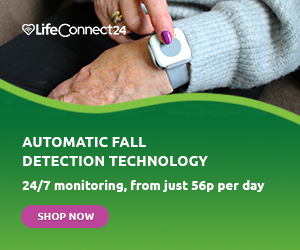Parkinson’s disease is a medical condition that causes problems with the brain. It’s a progressive condition, meaning that it gets worse over time. According to the NHS, Parkinson’s disease affects around one in 500 people. Parkinson’s UK estimates that there are currently around 145,000 people in the UK living with the condition.
Although it is most common among the over-50s, around one in 20 people with the condition will experience symptoms before they hit 40. Parkinson’s is also more common in men than women.
Our guide to medical conditions that affect older people covers Parkinson’s briefly. In this article, we’ll be taking a closer look at Parkinson’s disease, as we explain the symptoms, treatments, and possible causes of the condition.
What Is Parkinson’s Disease?
Parkinson’s disease is a neurological condition that affects the brain and nervous system. It is a progressive condition. Therefore, once symptoms begin, they will continue to worsen over time.
Parkinson’s happens when the brain can no longer produce enough of a chemical called dopamine. This chemical is responsible for sending messages to different parts of the brain in order to coordinate movement. Dopamine is produced by certain nerve cells in the brain. Sometimes, these cells die, which leads to the person developing symptoms of Parkinson’s disease.
What Causes Parkinson’s Disease?
As we’ve mentioned, the condition is triggered by a lack of dopamine. This is the chemical responsible for sending messages around the brain to coordinate movement. Once dopamine-producing cells start to die, the level of dopamine will fall slowly over many years – causing your existing symptoms to worsen and new symptoms to appear.
Currently, the causes of Parkinson’s disease aren’t totally clear. Experts believe it is probably a mixture of age, genetics, and environmental factors. These environmental factors could include toxins, chemicals, and head injuries to name a few. Some research indicates a link between pesticides and herbicides and the development of Parkinson’s.
While we don’t understand all the causes of Parkinson’s currently, research is ongoing. To find out more about the latest discoveries, see the Parkinson’s Foundation website.
Symptoms of Parkinson’s
There are three main symptoms of Parkinson’s disease:
- Slow movement – You might walk with short, shuffling steps and generally take longer to do everyday tasks.
- Muscle stiffness – This can cause cramps and pain, tightness, or inflexibility.
- Tremor – This is an involuntary movement in part of the body, such as the hand, head, legs, or voice.
These symptoms develop gradually and can be quite mild at first, although the severity can differ for each individual. People with Parkinson’s might not develop all these symptoms, or might develop them in a different order.
Besides these three main symptoms, the condition also has a number of other physical and mental symptoms.
Physical Symptoms of Parkinson’s
- Balance problems.
- Nerve pain.
- Loss of your sense of smell.
- Urination problems.
- Dizziness and blurred vision.
- Excessive sweating.
Mental Symptoms of Parkinson’s
- Depression.
- Anxiety.
- Mild cognitive impairment (slight memory loss).
- Dementia.
If you experience any of the above symptoms of Parkinson’s Disease, you should make an appointment with your doctor as soon as possible.
Diagnosis
Your doctor will base a diagnosis on your symptoms, medical history and a detailed examination. Unfortunately, no tests can conclusively show that you have Parkinson’s disease. Actual confirmation can take a while, since Parkinson’s shares symptoms with several other conditions.
In the early stages of Parkinson’s disease, symptoms tend to be relatively mild. Therefore, early diagnosis can be quite challenging. Your doctor may refer you to a neurologist (who specialises in the brain and nervous system) or a geriatrician (who specialises in problems affecting older people).
This specialist will ask you to perform some physical exercises to assess any issues with movement. You may also have an MRI or CT scan, which shows your specialist the structure of your brain.
Diagnosis is more likely if you have two of the three main symptoms of the condition. If your symptoms improve after taking a medication called levodopa, it’s likely you have Parkinson’s disease.
Treatment for Parkinson’s Disease
Unfortunately, there is currently no cure for Parkinson’s disease. However, there are some effective treatments to relieve pain and minimise symptoms.
There are several therapies that can help people with Parkinson’s. Physiotherapy helps with muscle stiffness and joint pain. Occupational therapy can help with any difficulty in everyday life. Speech and language therapy supports people who have difficulty swallowing.
Dietary therapy is also an option. Although there is no need to follow a specific diet, some of the symptoms and medications can affect your appetite. Certain foods can also prevent your medication from working correctly. A dietitian will work with you in order to help with the following issues:
- Swallowing problems.
- Constipation.
- Choosing the correct diet.
- Problems with buying and preparing food.
Medication for Parkinson’s Disease
Another treatment for Parkinson’s involves medicine that helps to minimise symptoms. There are three main types of medication which are effective against Parkinson’s. They are Levodopa, Monoamine Oxidase-B inhibitors, and Dopamine Agonists. In general, Parkinson’s drugs try to increase the dopamine in the brain or act as a dopamine substitute.
Everyone with Parkinson’s is different so don’t assume your medication or dosage should be the same as someone else’s. If you have any questions, be sure to check with your care team. Speaking with your specialist and GP is the best way to be sure you’re taking the right medication in the right way.
In very rare cases where drugs aren’t effective, surgery may also be an option. In a process called deep brain stimulation, surgeons implant a pulse generator into your chest wall. They connect two fine wires, which they place under the skin and insert precisely into specific areas in the brain. The pulse generator produces a tiny electric current, which runs through the wire and stimulates the part of the brain affected by Parkinson’s disease.
Living with Parkinson’s Disease
A diagnosis of Parkinson’s disease is life-changing. You will require long-term treatment in order to control your symptoms. and over time you will need to adapt the way that you complete everyday tasks.
Of course, one of the biggest impacts will be on your social and family life. Dealing with progressing symptoms may make you feel frustrated and depressed. Your family and carers will share these feelings too. Therefore, the NHS advises that you talk openly about how you feel. The people around you – friends, family, and colleagues – will want to help. Open communication is the best way to let them know how.
Parkinson’s Support Groups
It is important to know that there are support groups out there for people with Parkinson’s. Parkinson’s UK offers a wide range of support services online, at home, and in your local area. You can find out more by visiting their Support page.
I’ve Been Diagnosed with Parkinson’s Disease. Now What?
After your diagnosis, one of the first things you’ll need to do is inform the DVLA and your insurance company. You won’t necessarily have to stop driving. However, you will need to complete a form providing more information about your condition, as well as details of your doctors and specialists. All of this information will be taken into account to decide whether or not you are fit to drive.
You might also worry about your job. Many people with Parkinson’s are able to continue working for a long time after diagnosis, although you may need to make some changes depending on the severity of your symptoms. When it comes to work, here are some things to remember:
- Your employer has a duty to offer support and make reasonable changes.
- You need to inform your employer about your condition if your symptoms pose a health and safety risk to you or others.
- According to the Equality Act 2010 and Disability Discrimination Act 2006, it is unlawful for an employer to discriminate against you because of your disability or because of something that happens as a consequence of your disability.
You should take part in regular exercise. This helps to relieve muscle stiffness, improve your mood and relieve stress. There are various hobbies for you to pick up that can help you to remain active.
Staying Safe At Home
If you or someone you know has Parkinson’s disease, you might worry about staying safe in the home. A personal alarm can help protect people who suffer from long-term medical conditions. If one of our alarm users feels unwell, suffers a fall, or feels unsafe, they can call for assistance with just one touch of a button.
To find out more about our life-saving personal alarms, please speak to one of our friendly advisors on 0800 999 0400. Alternatively, complete our Contact Us form and we will get back to you as soon as possible.
For further information about other common medical conditions, please see our in-depth guide.
VAT Exemption
People with Parkinson’s Disease are eligible for VAT Exemption on a personal alarm system from LifeConnect24. This means that you won’t have to pay any VAT at all on your alarm system.
For a person to qualify they must meet certain criteria set by HMRC. These criteria state that the customer must have a long-term illness, a terminal illness, or a disability to qualify.
Editor’s Note: This article was updated on 29th June 2022 to reflect current information.


